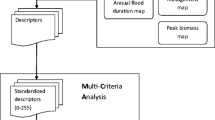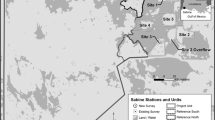Abstract
It is always challenging for decision makers to prioritize wetland conservation programs at the landscape scale. This study employed a GIS-based multi-criteria spatial decision support tool that identified locations with the highest restoration potential for wetland conservation programs in the Rainwater Basin in south-central Nebraska. Five indicators were considered to assess wetland restoration potential: (1) Vegetation characteristics; (2) Soil characteristics; (3) Water volume released from hydrological modification of agricultural irrigation pits; (4) Topographical depression status; and (5) Habitat condition. The results suggested 192 (1.6 % of the total) hydric soil footprints as the highest prioritized locations for future wetland restoration programs. The results also identified 901 footprints (7.7 % of the total) with medium-high restoration potential, 1,792 (15.2 % of the total) footprints with medium-low restorable potential and 8,875 (75.5 % of the total) footprints with low restorable potential. The methodology and statistical results contribute directly to the state’s Rainwater Basin Wetland Program Plan and are potentially applicable to the management of other wetlands across the region and globally.

Similar content being viewed by others
References
Abruzzes B, Leibowitz SG (1997) A synoptic approach for assessing cumulative impacts to wetlands. Environmental Management 21:457–475
Bedford BA (1996) The need to define hydrologic equivalence at the landscape scale for freshwater wetland mitigation. Ecological Applications 6:57–68
Bishop AA (2010) 2004–2009 Summary of habitat distribution and abundance throughout the Rainwater Basin wetland complex, U.S. fish and wildlife service, habitat and population evaluation team, Rainwater Basin joint venture
Bishop AA, Vrtiska M (2008) Effects of the wetland reserve program on waterfowl carrying capacity in the Rainwater Basin Region of South-Central Nebraska. A conservation effects assessment project wildlife component assessment
Carver S (1991a) Integrating multi-criteria evaluation with geographical information system. International Journal of Geographic Information System 5:321–339
Carver S (1991b) Site Search and multi-criteria evaluation. Planning Outlook 34(1):27–36
Cedfeldt PT, Watzin MC, Richardson BD (2000) Using GIS to identify functionally significant wetlands in the Northeastern United States. Environmental Management 26:13–24
Dahl T (2006) Status and trends of wetlands in the conterminous United States 1998–2004. U.S. Fish and Wildlife Service, Washington
Environmental Laboratory (1987) Corps of Engineers wetlands delineation manual. Technical report Y-87-1. Vicksburg, MS., U.S. Army Engineer Waterways Experiment Station
Fennessy MS, Jacobs AD, Kentula ME (2007) An evaluation of rapid methods for assessing the ecological condition of wetlands. Wetlands 27:543–560
Flanagan NE, Richardson CJ (2010) A multi-scale approach to prioritize wetland restoration for watershed-level water quality improvement. Wetlands Ecology and Management 18:695–706
Galatowitsh SM, van der Valk AG, Budelsky RA (1998) Decision-making for prairie wetland restorations. Great Plains Research 8:137–155
Haukos DA, Smith LM (1994) The importance of playa wetlands to biodiversity of the Southern High Plains. Landscape and Urban Planning 28:83–98
Hinton PR (1995) Statistics explained: a guide for social science students. Routledge, New York
Jacobs AD, Kentula ME, Herlihy AT (2010) Developing an index of wetland condition from ecological data: an example using HGM functional variables from the Nanticoke watershed, USA. Ecological Indicators 10:703–712
Kauffman-Axlrod JL, Steinberg SJ (2010) Development and application of an automated GIS based evaluation to prioritize wetland restoration opportunities. Wetlands 30:437–448
Kleinman D, Kupper L, Muller K (1988) Applied regression analysis and other multivariable methods. Duxbury Press, Belmont
Kramer L, Elliott M (2005) Identification of conservation opportunity areas in Georgia. GAP Analysis Bulletin 13:14–20
LaGrange TG (1997) Guide to Nebraska’s Wetlands and their conservation needs. Nebraska Game and Parks Commission, Lincoln
LaGrange TG, Stutheit R, Gilbert M, Shurtliff D, Whited PM (2011) Sedimentation of Nebraska’s Playa Wetlands: a review of current knowledge and issues. Nebraska Game and Parks Commission, Lincoln, p 62
Lin JP, Kleiss BA (2007) A wetland restoration spatial decision support system for the Mississippi Gulf Coast, U.S. Army Corps of Engineers, Engineer Research and Development Center, Environmental Laboratory, ERDC/FL TR-07-12
Liu C, Frasier P, Kumar L, Macgregor C (2006) Catchment-wide wetland assessment and prioritization using the multi-criteria decision making method TOPIS. Environmental Management 38:316–326
Mitsch WJ, Gosselink JG (1993) Wetlands. Van Nostrand Reinhold Co, New York, pp 578–579
Montgomery DR (2008) Dreams of natural streams. Science 319:291–292
National Research Council (NRC) (2001) Compensating for wetland losses under the Clean Water Act. National Academy of Sciences, Washington, DC, p 322
Nunnally JC, Bernstein HI (1994) Psychometric theory. McGraw-Hill, Inc, New York, pp 447–541
O’ Hara CG, Davis AA, Kleiss BA (2000) A decision support system for prioritizing forested wetland restoration in the Yazoo Backwater Area, Mississippi, Water Resources Investigation Report 00-4199, U.S. Geological survey
O’Neill MP, Schmidt JC, Dohbrowolski JP, Hawkins CP, Neale CMU (1997) Identifying sites for riparian wetland restoration: application of a model to the Upper Arkansas River Basin. Restoration Ecology 5:85–102
Possingham HP, Ball I, Andelman S (2000) Mathematical methods for reserve system design. In: Freson S, Burgman M (eds) Quantitative methods for conservation biology. Springer, New York, pp 291–267
Robichaux RM (2010) Correlating climate with late-winter wetland habitat in the Rainwater Basin, South-Central Nebraska, Master Thesis, Kansas State University
Robichaux RM, Harrington LMB (2009) Environmental conditions, irrigation reuse pits, and the need for restoration in the Rain Water Basin Wetland Complex, Nebraska. Papers of the Applied Geography Conferences 32:217–225
Russell GD, Hawkins CP, O’Neill MP (1997) The role of GIS in selecting sites for riparian restoration based on hydrology and land use. Restoration Ecology 5:56–68
Simenstad C, Reed D, Ford M (2006) When is restoration not? Incorporating landscape-scale processes to restore self-sustaining ecosystems in coastal wetland restoration. Ecological Engineering 26:27–39
Starks PJ (1984) Analysis of rainbasin depressions of Clay County, Nebraska, M.A., Thesis, Department of Geology/Geography, University of Nebraska-Omaha
Stein ED, Dark S, Longcore T, Grossinger R, Hall N, Beland M (2010) Historical ecology as a tool for assessing landscape change and informing wetland restoration priorities. Wetlands 30:589–601
Steyer GD, Sasser CE, Visser JM, Swenson EM, Nyman JA, Raynie RC (2003) A proposed coast-wide reference monitoring system for evaluating wetland restoration trajectories in Louisiana. Environmental Monitoring and Assessment 81:107–117
Stralberg D, Applegate DL, Phillips SJ, Herzog MP, Nur N, Warnock N (2009) Optimizing wetland restoration and management for avian communities using a mixed integer programming approach. Biological Conservation 142:94–109
Stutheit RG, Gilbert MC, Whited PM, Lawrence KL (2004) A regional guidebook for applying the hydrogeomorphic approach to assessing wetland functions of Rainwater Basin depressional wetlands in Nebraska. ERDC/EL TR-04-4, U.S. Army Engineer Research and Development Center, Vicksburg
USFWS (U.S. Fish and Wildlife Service) (1987) Soil-vegetation correlations in the sandhills and Rainwater Basin Wetlands of Nebraska. Biol Rep 87(11), September 1987, U.S. Fish and wildlife service, U.S. Department of the Interior
USNRCS (U.S. Natural Resources Conservation Service) (2008) The Wetland reserve program supports migrating waterfowl in Nebraska’s Rainwater Basin Region, CEAP conservation insight, September 2008
Voss K (2007) Mead Lake watershed wetland assessment project: developing wetland landscape metrics for effective planning and adapting the Milwaukee River basin approach for a small agricultural watershed, Final Report to U.S. EPA- Region V. Wetland Grant # CD 96511801
White D, Fennessy S (2005) Modeling the suitability of wetland restoration potential at the watershed scale. Ecological Engineering 24:359–377
Acknowledgments
This project was support by the US Environmental Protection Agency (EPA) (Grant ID: #CD97723501) and the Grant-In-Aid funds. None of the conclusions expressed here necessarily reflects views other than those of the authors. The research team sincerely appreciated the great support from the Rainwater Bain Joint Venture and the Nebraska Game and Parks Commission. The authors really appreciate the anonymous reviewers for their valuable comments and help in improving an earlier version of this article.
Author information
Authors and Affiliations
Corresponding author
Rights and permissions
About this article
Cite this article
Tang, Z., Li, X., Zhao, N. et al. Developing a Restorable Wetland Index for Rainwater Basin Wetlands in South-Central Nebraska: A Multi-Criteria Spatial Analysis. Wetlands 32, 975–984 (2012). https://doi.org/10.1007/s13157-012-0320-x
Received:
Accepted:
Published:
Issue Date:
DOI: https://doi.org/10.1007/s13157-012-0320-x




